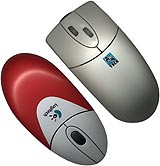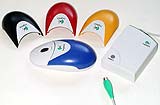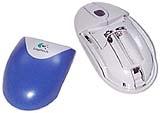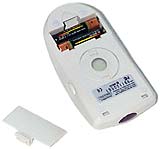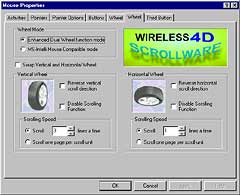
Logitech Cordless Wheel Mouse versus A-Four Tech Cable-Free 4D Mouse
Review date: 30 December 1999.
Last modified
03-Dec-2011.
I've got to say, I don't know what it is that some people seem to hate so much about mouse cables. Sure, maybe you have to control a presentation from the other side of the room or something, but for ordinary desktop computing tasks, I don't think having to deal with a mouse cord along with all of the other members of the typical computer cable collection is such a big deal.
If you disagree, though, there are some quite nice cordless mouses around now. Using either radio frequency (RF) or infrared (IR) transmitters, they get their signal to a receiver module that plugs in where a mouse's cable would go. The receiver can sit somewhere with line of sight to the mouse (for IR models) or pretty much anywhere nearby (for radio ones); either way, the number of cables snaking across your desk drops by one.
The mouses draw their power from on-board batteries - a couple of AAA cells, usually.
Here are a couple of likely contenders, one from Logitech, a big name in the mousing business, and one from A-Four Tech, which is not nearly so famous. Logitech's Cordless Wheel Mouse is a sleek and stylish RF unit, with two regular buttons and a wheel doohickey. A-Four Tech's Cable-Free 4D, model IRW-5, is an IR mouse with two normal buttons, a programmable thumb button, and two wheels.
The Logitech sells here in Australia for $AU99, or for about $US50 from various online outlets. This makes it more expensive than even serious show-off corded mouses like Microsoft's Intellimouse Explorer (reviewed here), though it's still much cheaper than Razer's outrageous Boomslang 2000 (reviewed here). The A-Four Tech mouse sells for $US25 or so, which makes it about the same price as various corded alternatives.
The colours... the colours...
The Logitech mouse is the show pony of the pair.
Its most obvious - and least useful - feature is that it comes with four differently coloured top panels. The top panel doubles as the battery compartment cover - it's held in place with a rather stiff clip on the underside. You can swap panels as the urge takes you, or just pick the one that matches your computer room decor.
Those of us that don't really have a computer room decor (does "junkyard" count as a decor?) are more interested in the Logitech mouse's technical virtues.
Aside from its coloured lid, it seems to be exactly the same, physically, as the unit that comes with the Logitech Cordless Desktop mouse-and-keyboard combo (an older version of which I review here; the current model is a bit funkier but works the same). It's a simple enough creature - two buttons, standard wheel doohickey, and a "Connect" button on the underside. There's a matching button on the receiver; if the mouse has trouble connecting, you press both buttons. It generally doesn't, though; power up your computer and it just works, like a regular PS/2 mouse.
Like the mouse in the Cordless Desktop package, the Cordless Wheel Mouse has a sample rate of only 50Hz - it updates the pointer position not more than 50 times per second, and slower if you're not moving it fast enough for there to be 50 discrete pointer locations in a second. You can wind the sample rate lower with outboard software (like PS2Rate), but not higher. If you're game-mad or just really like super-smooth mouse movement, 50Hz might not meet your demanding standards. Generally, though, it's fine, and much better than the horribly steppy 33Hz of standard Windows 95/98 serial and PS/2 mouses.
The Logitech's wheel feels a tiny bit rough, and has the somewhat stiff action that every big name wheelie-mouse up until Microsoft's most recent models uses. There's nothing wrong with it at all, but I prefer the light feel of the Intellimouse Explorer's wheel.
The Logitech mouse also feels a bit bulbous around the rump, because of its top-mounted batteries. It's not peculiar enough that I think anyone would find it uncomfortable, but it's not as generically lovable as the vanilla cabled Logitech First Mouse + (click here to see Logitech's page for it, or here for the USB version), which is a lovely slimline unit that fits pretty much all hand sizes perfectly. The cordless mouse is still perfectly symmetrical, though; left-handed users will have no problems.
The radio range of the Logitech mouse is good - at least six feet, and probably more, depending on how much RF noise there is in the vicinity, and on the receiver location and orientation, and the usual voodoo RF propagation oddities. You should be able to use this mouse from the couch and control a computer feeding its output to a TV with no trouble at all.
Logitech include their MouseWare software on a CD with the Cordless Wheel Mouse, but you don't have to install it. It has the usual speed adjustment and button mapping features, but the mouse works without it. The chief reason to install the software is to get a low battery warning; there's no warning light on the receiver unit (the full Cordless Desktop outfit gives you such a light), so without MouseWare you just have to wait until your mouse starts misbehaving.
The challenger
I wasn't optimistic about the quality of the A-Four Tech mouse. IR cordless mouses have, traditionally, been balky things that keep losing signal, and cheapo mouses from Chinese companies are not exactly renowned for their engineering.
But I was pleasantly surprised. The A-Four Tech mouse is actually quite a nice piece of gear.
The A-Four unit gets around the IR signal loss problem by putting two transmitter LEDs in the front of the mouse, giving it a quoted 160 degree transmission angle, horizontally at least. Its vertical beam is not nearly as impressive, but that doesn't matter; you're not moving the mouse in the pitch axis.
The receiver unit is a two inch wide translucent purple dome with self-adhesive Velcro under it; you're meant to stick it where the mouse can see it. This is easy to get right, because there's a green LED on the IR receiver that blinks when it's getting data from the mouse. It glows constantly when you move the mouse, if it's getting good signal.
The A-Four mouse is billed as having a one metre range, which seems pretty much right. The quoted 160 degree working angle claim also seems pretty fair; in fact, you may be able to do a lot better, depending on the surfaces near the mouse. As with IR remote controls, even quite non-reflective surfaces can bounce the mouse's signal to the receiver at all sorts of funny angles. But if you're more than a metre from the receiver the signal starts flaking out, so this is not the mouse to use for couch-to-TV ranges.
The small slide-feet under the A-Four mouse give it a pleasingly smooth action - rather too smooth, actually, on my Everglide mouse pad - and its shape is quite comfortable, too. If you've got unusually large hands, the Logitech will probably suit you better, but for a cheap mouse, this one feels nice.
The A-Four mouse's scroll wheels are unusual. They're very low profile, and they don't serve as buttons - unlike most wheel doohickeys, they can't be pushed down to give you a third-button-click. They also have no detents - they just turn smoothly, without clicking from one position to the next. This makes them quite annoying for use as weapon selectors in games; the wheels are quite sensitive, so it's close to impossible to move them a set number of steps to pick the gun you want. For plain Windows scrolling they're fine.
By default, the two wheels are rather confusing - the top-left one as you hold the mouse works in the same way as a normal scroll wheel, where moving it upward scrolls up. The bottom-right wheel, however, works in reverse - for it, up is down.
Install the 4D Mouse software, though, and the bottom-right wheel becomes more useful. Now its up-down axis does left-right scrolling, by default. The 4D driver - a mucked-about-with version of Microsoft's Intellimouse software - lets you change the behaviour of the wheels as you like, reversing their action, changing the axes they refer to and so on.
You can also program the behaviour of the thumb button on the A-Four mouse's left side. This, of course, is a "thumb" button only for right-handed users; the A-Four mouse's configurability means it's generally just as easy to use for lefties, but the extra button becomes close to useless.

The extra button works, by default, as a plain third button - like clicking the wheel on the Logitech mouse. With the 4D driver software, it can zoom the area of the desktop under the cursor - you can say how much area, and how much to zoom - or it can perform the same auto-scroll function that you get from most regular wheel doohickeys or third buttons, where a four-arrows pointer appears and moving the mouse scrolls the window.
You can also set the thumb button to various Windows-ish functions or qualifier keys. This lets you use it in games quite simply; as with the side buttons on the Intellimouse Explorer (which are just as useless for left-handers), you can set the A-Four mouse's side button to, say, Page Up, and then run your game and bind Page Up to whatever command you want - zoom, or next weapon, or whatever.
The A-Four mouse has a comfortably high 90Hz sample rate - not quite as good as the 125Hz of USB mouses, but good enough. With its battery compartment on the underside, the A-Four mouse lacks the Logitech unit's big bottom; it's comfy to hold, it's smooth to use (A-Four quote its resolution at 520 dots per inch, which is a bit higher than usual), and for the money, it seems a great mouse.
But.
The 4D mouse has one annoying quirk. Sometimes it won't wake up properly.
When the A-Four isn't doing anything, the activity light on the front of the receiver pulses slower and slower, and after about 7 seconds turns off completely, indicating that the mouse isn't sending pulses any more, to save battery power (see below). Well, usually it does; sometimes the mouse just seems to want to keep yakkin' for a while. The mouse is (obviously) supposed to wake up again when you move it; it takes it a fraction of a second to start sending data again, but it's not enough to be annoying.
Sometimes, though, it didn't wake up just because I'd moved it; it took a button press or wheel scroll to activate it again. There seemed to be no particular thing I had to do, or not do, to make this problem arise; plugging in or removing simultaneously installed USB mouses made no difference, it wasn't flat batteries, and it happened whether or not the 4D support software was installed.
The A-Four mouse won't go to sleep on you while you're moving it around - well, not if its AAAs aren't flat, anyway - but the seven-second timeout means it doesn't take it long to do so when you stop using it. Usually, it wakes up just fine, but it fails often enough to be irritating.
If not for this problem, I'd unreservedly recommend this mouse to anyone who didn't need a clicky wheel or a third button lefties could use; with the sleep problem, I'm less than enthused.
Battery life
Makers of cordless peripherals tend to be squirrelly about how long the batteries can be expected to last. This is mainly because it's hard to be sure; the more intensively the gadget is used, and the lousier the brand of cell you use, and the more inclement the weather (the colder it is, the less capacity you'll get), the shorter will be the life of a given set of AAAs in either of these mouses.
Let's say you use decent alkaline AAAs. Good alkalines have a capacity of about 1100 milliamp-hours (mAh) - they can deliver a current of 1 milliamp (mA) for 1100 hours, or 10mA for 110 hours.
The A-Four mouse comes with a couple of "Titen" cells which are trying really hard to look like Duracells, and may or may not have the same capacity. The Logitech comes with a couple of real Duracells.
In use - moving the mouse and clicking - the A-Four mouse draws 4 milliamps. When stationary, it draws 1mA during the few seconds while it ramps down its pulse rate, and then a varying amount of current that seems to average about 0.1mA, once it enters sleep mode.
The Logitech mouse draws 7 milliamps when in use, 6mA for a few seconds afterwards, and then a steady 0.6mA or so for a few minutes, dropping to 0.1mA when it goes into its own full sleep mode (from which it never seems to have any trouble awakening).
Your mileage will vary, of course, but these numbers mean either mouse should be good for about three months of use from one pair of AAA cells. The A-Four's batteries should last a bit longer, but in practice there probably won't be a great deal of difference. Neither mouse is a battery hog.
Overall
If the idea of performing regular wake-up clicks doesn't irk you, you'll be happy with the A-Four mouse. Heck, maybe I just got a lemon for review, or it's something weird to do with my test systems; I'll check out more of the A-Four mouses and update the review if the problem turns out to be isolated. But if the A-Four's sleep problem is a general one, the Logitech wins for me. If you ignore the sleep problem, the A-Four is clearly better value, unless you really need the Logitech's extra range, or adore its changeable lids, dahling.
I still have to say, though - is a cordless mouse really necessary? The batteries last well, and the mouses aren't very big or heavy, but I think a lot of people that buy these things do it just for the cool-factor. Not that there's anything wrong with that.
But in the Poseur Mouse stakes, I'll stack my glowing silver Explorer up against your tasteful multi-hued Logitech any day of the week!
Buy one!
Aus PC Market don't sell this
product any more (click
here to see their current case-related products), but you can still
try a price search at
DealTime!)
